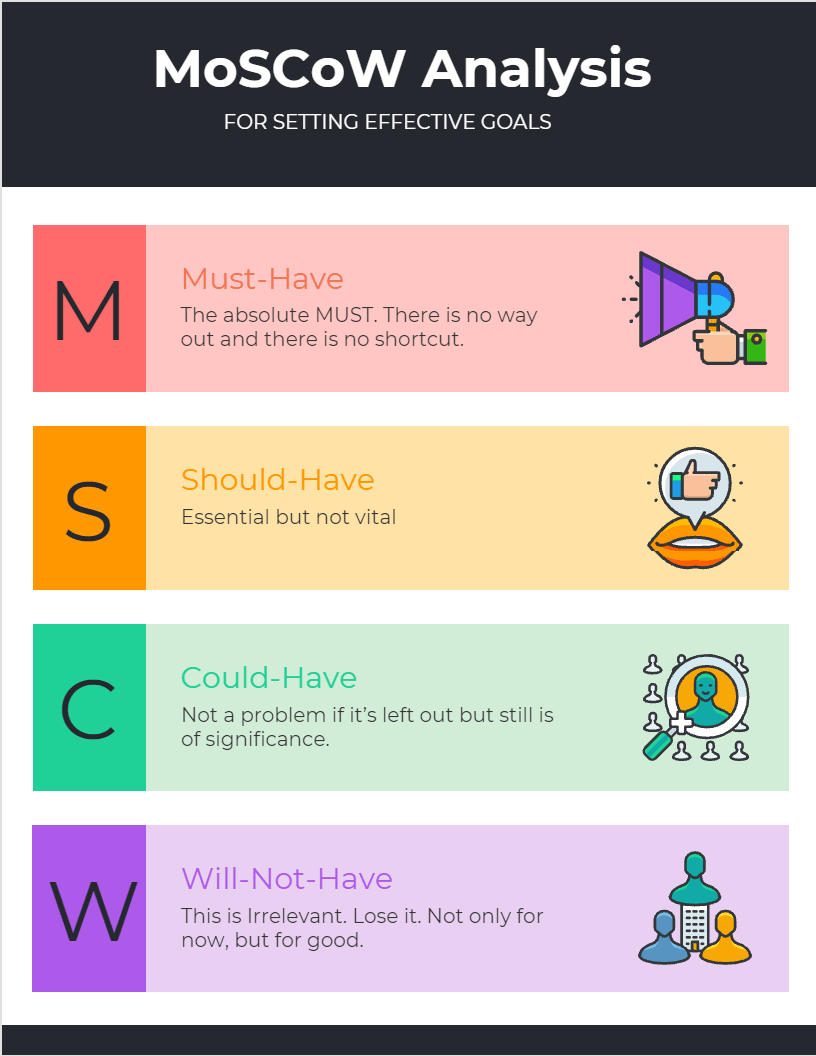How to Prioritize Your Tasks with the MoSCoW Method
You’re a busy person. Between work, school, and taking care of the kids, you’re stretched as thin as you can be without tearing. You have a long list of tasks that needs to get done, but you don’t know where to start. Of course, there are those big-ticket items like paying bills and getting your taxes done, but what about all of those one-off tasks?
Here we’ll talk about the MoSCoW method. This is a great way to prioritize and organize your “to do” list.
What Is the MoSCoW Method?
There are a variety of methods and models for prioritizing tasks. The one we’ll be talking about today is the MoSCoW method. There’s no official definition, but it’s popularly known as:
“MUST do, Should do, Could do, Won’t do.”
Creating a hierarchical list of tasks can help you divide and conquer, and you’ll have an easier time knowing what to work on first and then order your goals should be completed. It’s also great for setting goals throughout the year, primarily if you use the same method year after year.
What is MoSCoW?
Before we get started on this, there are a couple of things about this method.
First, it’s not perfect, and it’s meant to be quick and easy, but sometimes tasks will fall in the wrong category, which can cause problems.
Second, this is a standard prioritization method. We’ll be talking about priority in terms of how long it takes to complete a task and the order they should be completed in. This assumes that all functions have an equal amount of importance or priority.
Third, you can’t use this method for everything! It’s best used to have a list of tasks that have similar priorities.
What Are the Categories?
Every task in your to-do list or project should fall into one of the following categories:
MUST DO – these are things that have to get done. This is work-related and time-sensitive; it has the highest priority, and you need to focus all of your attention on it.
SHOULD DO – these are tasks that you think should get done but aren’t time-sensitive (meaning they can wait) and not directly related to work. These things may be necessary but less urgent than MUST DOs.
COULD DO – this is usually work-related and time-sensitive but not as crucial as SHOULD DOs. You can put this stuff off until later, but it’s still important enough to get done eventually.
WON’T DO – these are tasks that either isn’t work-related or they don’t have a deadline/due date. They could be things like chores around the house, TV time, shopping, etc. These tasks aren’t urgent and usually don’t require time.
When To Use the MoSCoW Method?
You can use the MoSCoW method for any goal you set for yourself throughout the year. Any long-term or yearly goals work well here, especially if they’re similar in priority. It’s also helpful for organizing your daily work tasks for the week.
How to Prioritize Using the MoSCoW Method?
Now that you understand the MoSCoW method, it’s time to get started using it! Here are some things you can do:
-Create an outline of your Priority 1 (MUST DO), Priority 2 (SHOULD DO), Priority 3 (COULD DO), and Priority 4 (WON’T DO) tasks. You can even give these categories fancy names if you’d like.
Prioritize your list of tasks by assigning them to the appropriate category. If there are multiple items in one priority, put them in descending order with the most crucial task at the top of the type.
For Example, a Product Manager Might Have the Following List of Tasks To Complete for a Project:
Priority 1 (MUST DO)
-Review client contract
-Finalize product information sheet
Priority 2 (SHOULD DO)
-Create demo plan for product presentation
-Build social media strategy around a new product launch
Priority 3 (COULD DO)
Finalize sales pitch for a client meeting
Plan new product launch event
Priority 4 (WON’T DO)
Start brainstorming blog post ideas for the company website
Write a filler report for the new product launch.
The list is prioritized correctly, but some items need to be moved into another category. For example, “Plan new product launch event” was meant to be Priority 3 (COULD DO), but it fits better in the MUST DO category because it happens before the client meeting. The task needs to be completed before the presentation, or it won’t make for a very effective demo!
Another example is the blog post ideas; this task can be moved from Priority 4 to Priority 3 because it’s not a MUST DO, but it still needs to get done eventually.
In the End, This Product Manager Should Have an Outline That Looks Like This:
Priority 1 (MUST DO)
Review client contract
Finalize product information sheet
Create demo plan for product presentation
Build social media strategy around a new product launch
Priority 2 (SHOULD DO)
Finalize sales pitch for a client meeting
Plan new product launch event
Start brainstorming blog post ideas for the company website
Priority 3 (COULD DO)
Write a filler report for the new product launch
Once you’ve finished your prioritization, it’s time to get to work! Remember: this list is not set in stone and can be re-prioritized as needed. If something doesn’t make sense in its priority, feel free to change it around to suit you better. Remember that this is your schedule, not anyone else’s! Don’t be afraid to take charge and do whatever needs to be done.
With the MoSCoW method, you can always be sure you’re staying on top of everything. It’s a great way to stay organized and prioritize work effectively to achieve your goals without the stress!
Some Tips for Using MoSCoW:
-Do NOT try to use this method for every task in your day! This only works when you have multiple functions within one priority level. If all of your assignments are important, it’s best not to use this method at all. Keep some things on your list that don’t fit into any categories. This will help you stay flexible and give you more options during the day.
-If your list gets too long, put some tasks into another category! Sometimes it can be tough to sort all of your tasks into four priority levels, so don’t worry about things not fitting 100%. The main idea is that each job has a group of priorities and if it doesn’t fit into one category, simply put it in another.
-If you need more than four priority levels, this isn’t the method for you! This system is meant to be quick and easy, so don’t try to force tasks into categories that may not fit. It’s better to keep things as they are than to have a method that may not work.
-If you have too many priority tasks or are equally important, it’s best to break them up into multiple lists. Otherwise, you’ll likely overwhelm yourself with too much at once and won’t be able to stay organized and on task.
In Conclusion
The MoSCoW method is a great way to prioritize your tasks and goals, especially when you have multiple items within one priority level. It’s best used for yearly plans, long-term projects, or work-related tasks similar in importance. If you try this out and find it doesn’t fit your needs, there are many other ways to prioritize your life!



